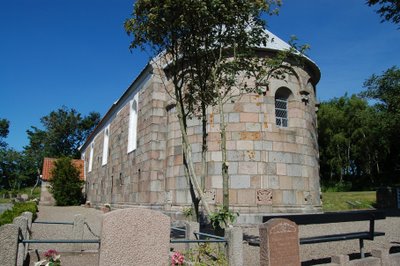
Ræhr church, Thy, 15 km north of Thisted

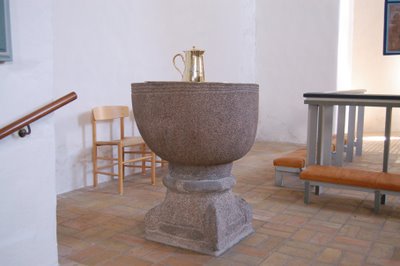
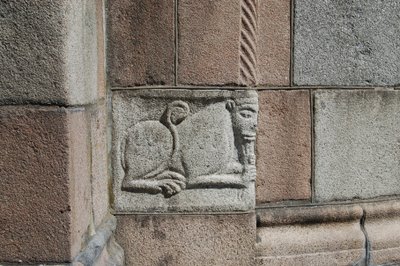




Ræhr Church is one in a small group of Danish churches which was built by an English building master in the end of the 1000s like Vestervig in Thy, Lihme in Salling and Vejby in North Sjælland. The church was built like a cross in granite ashlars with an eastern apse and a very unusual longhouse without an individual choir, but with cross arms by the eastern part of the building. Obviously the well carved granite ashlars came to an end, for the western part of the church is built in raw granite boulders. The cross arms were supposedly knocked down in the 1700s and in 1800 a modest porch was built by the south side.
The apse is the greatest attaction. A masterpiece in Romanesque style with five round arched arcade fields, divided by half circular pillars. The play of the colours in the granite is unique, but most important are the base of the pillars. They are shaped individually in a mixed style of the winding ornamentations from the Viking period and the lion figures and classical inspired flower reliefs of Romanesque preference.
The Communion table is one long limestone block , covered with a wooden panel. The altar piece is a late Gotich triptychon from ab. 1500 , and above is a Renaissance 'top piece' from ab. 1600-25. The pulpit is Renaissance from the beginning of the 1600s - in Thisted type with arcades. The Romanesque granite font is Thybo-type. The choir crucifix is late Gothic from ab. 1450-1500, and the late Gothic parish clerk's stool has panelwork from 1600s. The church bell, which is placed outside by the gable is from 1453 by Petrus de Randrusia.
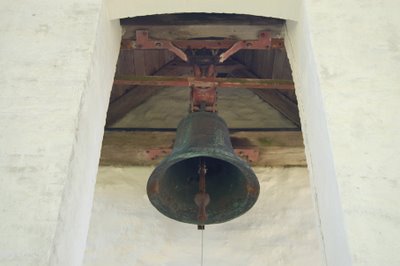
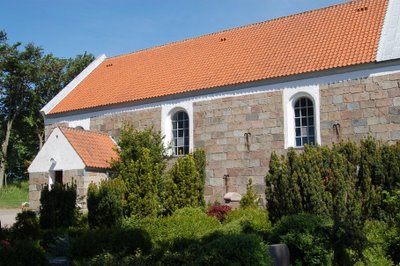
Names in the Middle Ages and the 1600s:
Ræer (* 1455 røre, 1498 Rære); Pugdal (1603 Puudal, 1664 Pugdahl); Febbersted (1602 Feberstedt); Hedegård (1651 Heegaard); Nørtorp or Gammel Torp ( 1365 Thorp, 1664 Nør Torp); Borup (1651 Byorup, 1664 Boorup); Hjertebjerggård ( 1652 Hiertbiere, 1664 Hiertberig); Heskær (1562 Hestkier).
The farm/manor Torp (later Nørtorp) was probably originally a royal manor, possibly established by Valdemar Atterdag. 1365 the King's Thing was held here, and in 1401 queen Margrethe endowed the manor to hofmester Jens Bondesen Due (of the family with an eagle in their coat of arms). He must have achieved the ownership of Torp, since it was inherited by his son Bonde Jenssøn Due. He was married to Johanne Andersdatter Panter, and by the division of the estate after her paternal grandfather Niels Offesøn (Ovesen) Panter of Asdal 1419 there must have been an exchange of property, since her stepfather Lyder Kabel thereafter got Torp. He was the owner in 1442, and after his death it was inherited by his daughter Else Due, married to Anders Nielssøn Munk (The family Bjælke-Munk). After this the family Munk owned Torp until ab. 1521, where it was taken over by other families from the nobility through the next couple of centuries. Several owners until today.
A little southwest of Nytorp by the foot of the tall steep banks is Torp or Nørtorp Voldsted (castle bank) on the flat ground of a dried-up lake. It's a tall almost square bank which earlier was protected on three sides with water, while the moats (still seen) gave protection to the north. Inside are found early building materials. The type is considered a late medieval manor place. Maybe the castle was establised by Valdemar Atterdag.
In a sandbank by the farm Nørtorp was in 1675 found en 'hob' (bunch) of silver coins, turnoser from the French king Philippe and sterlings from the English king Edward, probably hidden in the period 1330-40.
Listed prehistorics: 9 hills, i.e. the high placed Hjertebjerg Høj; the others are rather small and are mainly placed along the southern edge of the high plateau.
Demolished or destroyed: 26 hills, several were demolished by the German Wehrmacht during WWII; they contained small coffins with skeleton burials from Roman Iron Age.
Source: Trap Danmark, Thisted amt, 1961; Politikens bog om Danmarks kirker.
photo 14 June 2006: grethe bachmann
1 comment:
My name is Søren Olsen and my family is from Ræhr. I visited the church while visiting Denmark in 2010. I'm trying to locate relatives living in the area. I believe Benta Lillian Sørensen dob 15 June 1943 is related to me. Any information would be greatly appreciated.
Post a Comment